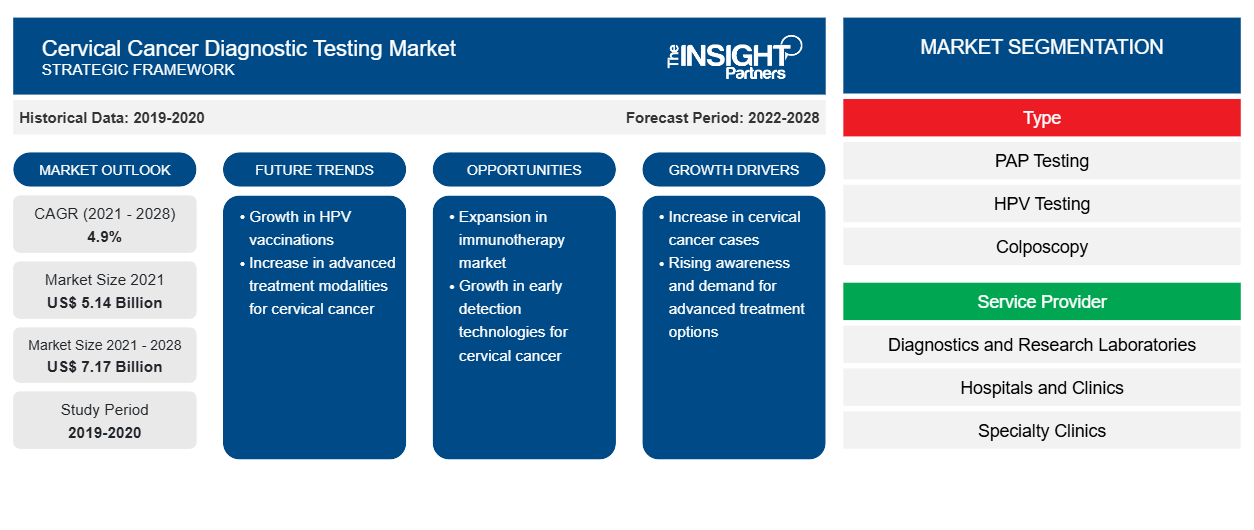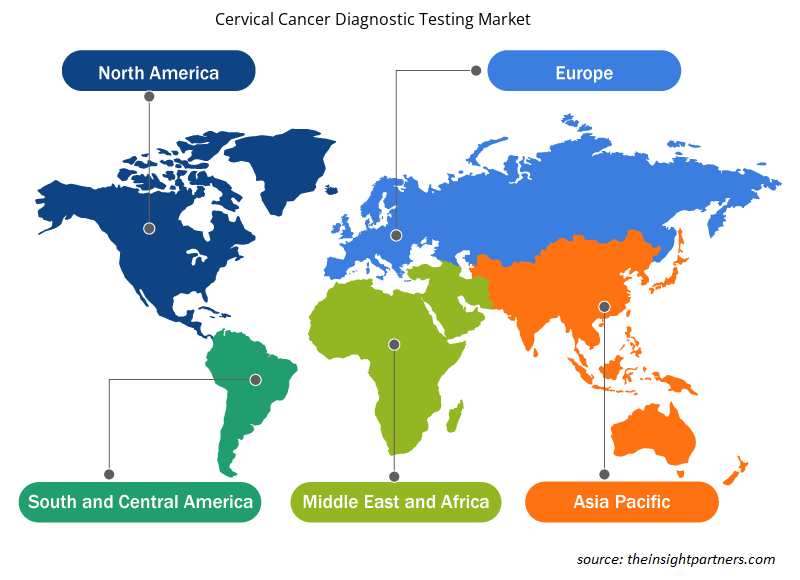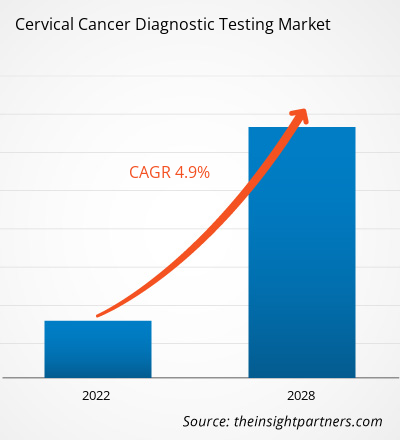The cervical cancer diagnostic testing market is projected to reach US$ 7,165.92 million by 2028 from US$ 5,141.25 million in 2021; it is expected to grow at a CAGR of 4.9% from 2021 to 2028.
Cervical cancer has a significant mortality rate (almost 50%), which can be lowered with early detection and prevention. Precancerous alterations offer opportunities for prevention and treatment because disease progression is often delayed. However, due to a lack of awareness or access to diagnostic services, many cases are detected at later stages of illness progression. Human Papillomavirus (HPV) is a primary cause of cervical cancer that is typically transmitted through sexual contact. There are over 100 HPV strains, and 13 of which are high-risk or carcinogenic. The active gene - E6 or E7 - determines whether an HPV strain is high or low risk. E6 binds to p53, causing proteolytic destruction. E7, on the other hand, binds to retinoblastoma; the binding displaces previously attached transcription factors, resulting in the cell cycle being stopped and apoptosis regulation being inhibited. The HPV test detects human papillomavirus in cervical cells. Other screening approaches employed in low-resource areas of developing countries are HPV DNA testing and visual inspection. Cervical screening on a regular basis aids in an early detection of cervical cancer, lowering the mortality rate from the disease. Every three years, all women between the ages of 21 and 65 are advised to have a Pap test, and women between the ages of 30 and 65 are advised to have both a Pap and an HPV test. In terms of revenue, this type dominated the cervical cancer screening market in 2021, and it is expected to continue its dominance during the forecast period.
Customize This Report To Suit Your Requirement
You will get customization on any report - free of charge - including parts of this report, or country-level analysis, Excel Data pack, as well as avail great offers and discounts for start-ups & universities
Cervical Cancer Diagnostic Testing Market: Strategic Insights

- Get Top Key Market Trends of this report.This FREE sample will include data analysis, ranging from market trends to estimates and forecasts.
Customize This Report To Suit Your Requirement
You will get customization on any report - free of charge - including parts of this report, or country-level analysis, Excel Data pack, as well as avail great offers and discounts for start-ups & universities
Cervical Cancer Diagnostic Testing Market: Strategic Insights

- Get Top Key Market Trends of this report.This FREE sample will include data analysis, ranging from market trends to estimates and forecasts.
Market Insights
Increasing Prevalence of Cancer to Drive Cervical Cancer Diagnostic Testing Market Growth During Forecast Period
Cancer has emerged as a leading cause of death across the world. According to the World Health Organization (WHO), cancer was the first leading cause of death in the people of below 70 years in 183 countries and fourth leading cause of death in 123 countries worldwide in 2019. In addition, according to data published by the WHO in March 2021, ~10 million deaths occurred in 2020 due to different cancer types. The rising incidence of cervical cancer among women worldwide drives the cervical cancer diagnostic testing market growth. According to the WHO, more than 270,000 deaths of women are recorded due to cervical cancer each year. Cervical cancer mortality rates are greater in low-income countries due to the late diagnosis of the disease. The market is predicted to grow in the coming years due to the increasing acceptance of cervical cancer diagnostic tests for the early detection of the disease.
The increasing prevalence of cancer has created burden on the healthcare systems across the world. According to International Agency for Research on Cancer (IARC), the global burden of new cancer cases is estimated to reach ~ 27.5 million by 2040, and the disease is likely to be a cause of ~163 million deaths by that year. Factors such as lifestyle changes, smoking, reduced physical activities, and uncertain health and climatic conditions are would lead to even greater burden of cancer in the world in the coming years.
Type-Based Insights
Based on type, the cervical cancer diagnostic testing market is segmented into PAP testing, HPV testing, colposcopy, cervical biopsies, cystoscopy, and others. In 2021, the PAP testing segment held the largest share of the market, and it is estimated to register the highest CAGR during 2021–2028.
Service Provider-Based Insights
Based on the service provider, the market is segmented into research, diagnostics and research laboratories, hospitals and clinics, specialty clinics, and home care services. In 2021, the diagnostics and research laboratories segment held the largest share of the market and is expected to register the highest CAGR in the market during 2021–2028.
Companies operating in the cervical cancer diagnostic testing market are adopting various strategies such as, product innovations, to meet the evolving customer demands across the world and maintain their brand name in the global market.
Cervical Cancer Diagnostic Testing Market – Segmentation
The cervical cancer diagnostic testing market is segmented on the basis of type, and service provider. Based on type, the market is sub-segmented into PAP testing, HPV testing, colposcopy, cervical biopsies, cystoscopy, and others. Based on the service provider, the market is further segmented into diagnostics and research laboratories, hospitals and clinics, specialty clinics, and home care services.
In terms of geography, the cervical cancer diagnostic testingmarket is segmented into North America (the US, Canada, and Mexico), Europe (France, Germany, Italy, the UK, Spain, and Rest of Europe), Asia Pacific (Australia, China, India, Japan, South Korea, and Rest of APAC), the Middle East & Africa (Saudi Arabia, South Africa, the UAE, and Rest of MEA), and South and Central America (Brazil, Argentina, and Rest of SCAM).
Cervical Cancer Diagnostic Testing Market Regional Insights
The regional trends and factors influencing the Cervical Cancer Diagnostic Testing Market throughout the forecast period have been thoroughly explained by the analysts at Insight Partners. This section also discusses Cervical Cancer Diagnostic Testing Market segments and geography across North America, Europe, Asia Pacific, Middle East and Africa, and South and Central America.

- Get the Regional Specific Data for Cervical Cancer Diagnostic Testing Market
Cervical Cancer Diagnostic Testing Market Report Scope
| Report Attribute | Details |
|---|---|
| Market size in 2021 | US$ 5.14 Billion |
| Market Size by 2028 | US$ 7.17 Billion |
| Global CAGR (2021 - 2028) | 4.9% |
| Historical Data | 2019-2020 |
| Forecast period | 2022-2028 |
| Segments Covered |
By Type
|
| Regions and Countries Covered | North America
|
| Market leaders and key company profiles |
Cervical Cancer Diagnostic Testing Market Players Density: Understanding Its Impact on Business Dynamics
The Cervical Cancer Diagnostic Testing Market market is growing rapidly, driven by increasing end-user demand due to factors such as evolving consumer preferences, technological advancements, and greater awareness of the product's benefits. As demand rises, businesses are expanding their offerings, innovating to meet consumer needs, and capitalizing on emerging trends, which further fuels market growth.
Market players density refers to the distribution of firms or companies operating within a particular market or industry. It indicates how many competitors (market players) are present in a given market space relative to its size or total market value.
Major Companies operating in the Cervical Cancer Diagnostic Testing Market are:
- F. HOFFMANN-LA ROCHE LTD.
- Abbott
- Quest Diagnostics Incorporated
- QIAGEN
- Hologic, Inc.
Disclaimer: The companies listed above are not ranked in any particular order.

- Get the Cervical Cancer Diagnostic Testing Market top key players overview
Company Profiles
- F. Hoffmann-La Roche Ltd.
- Abbott
- Quest Diagnostics Incorporated
- QIAGEN
- Hologic, Inc.
- DYSIS Medical Inc.
- Femasys Inc.
- Guided Therapeutics, Inc.
- Cooper Companies, Inc.
- BD
Frequently Asked Questions
Which region is expected to witness significant demand for the cervical cancer diagnostic testing market in the coming years?
Asia Pacific is registered as the fastest-growing region in the global cervical cancer diagnostic testing market. The market is this region is expected to grow significantly in countries such as China, Japan, and India. The market is driven by the increasing prevalence of cervical cancer in developing countries, including China, India, Malaysia, Japan, South Korea, and Australia.
Which is the most influencing segment growing in the cervical cancer diagnostic testing market report?
The cervical cancer diagnostic testing market based on type is segmented into PAP testing, HPV testing, colposcopy, cervical biopsies, cystoscopy, others. In 2021, the PAP Testing segment accounted for the highest share. Besides, the HPV testing segment is expected to grow at a CAGR of 5.5% in the forecast period.
What is the market value of the cervical cancer diagnostic testing market based on region?
The global cervical cancer diagnostic testing market is segmented into North America, Europe, Asia Pacific, Middle East & Africa, and South & Central America. The North American area holds the largest market for aesthetic skin devices. The United States held the most significant cervical cancer diagnostic testing market and is expected to grow due to factors such as high awareness about disease prevention among women in the region, as well as to the many initiatives launched to prevent cervical cancer, which have increased the reach of insurance coverage for cervical screening tests, especially for low-income women, and others.
Who are the major players in the cervical cancer diagnostic testing market?
The cervical cancer diagnostic testing market majorly consists of the players such as as F. Hoffmann-La Roche Ltd., Abbott, Quest Diagnostics Incorporated, QIAGEN, Hologic, Inc., DYSIS Medical Inc., Femasys Inc., Guided Therapeutics, Inc, Cooper Companies, Inc., BD are amongst others.
What is Cervical Cancer Diagnostic Testing?
Cervical Cancer refers to cancer that occurs in the cells of the cervix i.e. the lower part of the uterus that connects to the vagina. In 90% of the cases, cervical malignancies occur due to the HPV infection and are diagnosed through smear screening.
What are the factors impacting the cervical cancer diagnostic testing market?
The factors that are driving and restraining factors that will affect the cervical cancer diagnostic testing market in the coming years. Factors such as the increasing prevalence of cancer and the rise in HPV infections are driving the market growth. However, less number of commercially available vaccines for the treatment of cancer are likely to hamper the growth of the market.
- Historical Analysis (2 Years), Base Year, Forecast (7 Years) with CAGR
- PEST and SWOT Analysis
- Market Size Value / Volume - Global, Regional, Country
- Industry and Competitive Landscape
- Excel Dataset
Testimonials
I wish to appreciate your support and the professionalism you displayed in the course of attending to my request for information regarding to infectious disease IVD market in Nigeria. I appreciate your patience, your guidance, and the fact that you were willing to offer a discount, which eventually made it possible for us to close a deal. I look forward to engaging The Insight Partners in the future, all thanks to the impression you have created in me as a result of this first encounter.
DR CHIJIOKE ONYIA, MANAGING DIRECTOR, PineCrest Healthcare Ltd.The Insight Partners delivered insightful, well-structured market research with strong domain expertise. Their team was professional and responsive throughout. The user-friendly website made accessing industry reports seamless. We highly recommend them for reliable, high-quality research services
Yukihiko Adachi CEO, Deep Blue, LLC.Reason to Buy
- Informed Decision-Making
- Understanding Market Dynamics
- Competitive Analysis
- Customer Insights
- Market Forecasts
- Risk Mitigation
- Strategic Planning
- Investment Justification
- Identifying Emerging Markets
- Enhancing Marketing Strategies
- Boosting Operational Efficiency
- Tracking Industry Innovations
- Aligning with Regulatory Trends
Yes! We provide a free sample of the report, which includes Report Scope (Table of Contents), report structure, and selected insights to help you assess the value of the full report. Please click on the "Download Sample" button or contact us to receive your copy.
Absolutely — analyst assistance is part of the package. You can connect with our analyst post-purchase to clarify report insights, methodology or discuss how the findings apply to your business needs.
Once your order is successfully placed, you will receive a confirmation email along with your invoice.
• For published reports: You’ll receive access to the report within 4–6 working hours via a secured email sent to your email.
• For upcoming reports: Your order will be recorded as a pre-booking. Our team will share the estimated release date and keep you informed of any updates. As soon as the report is published, it will be delivered to your registered email.
We offer customization options to align the report with your specific objectives. Whether you need deeper insights into a particular region, industry segment, competitor analysis, or data cut, our research team can tailor the report accordingly. Please share your requirements with us, and we’ll be happy to provide a customized proposal or scope.
The report is available in either PDF format or as an Excel dataset, depending on the license you choose.
The PDF version provides the full analysis and visuals in a ready-to-read format. The Excel dataset includes all underlying data tables for easy manipulation and further analysis.
Please review the license options at checkout or contact us to confirm which formats are included with your purchase.
Our payment process is fully secure and PCI-DSS compliant.
We use trusted and encrypted payment gateways to ensure that all transactions are protected with industry-standard SSL encryption. Your payment details are never stored on our servers and are handled securely by certified third-party processors.
You can make your purchase with confidence, knowing your personal and financial information is safe with us.
Yes, we do offer special pricing for bulk purchases.
If you're interested in purchasing multiple reports, we’re happy to provide a customized bundle offer or volume-based discount tailored to your needs. Please contact our sales team with the list of reports you’re considering, and we’ll share a personalized quote.
Yes, absolutely.
Our team is available to help you make an informed decision. Whether you have questions about the report’s scope, methodology, customization options, or which license suits you best, we’re here to assist. Please reach out to us at sales@theinsightpartners.com, and one of our representatives will get in touch promptly.
Yes, a billing invoice will be automatically generated and sent to your registered email upon successful completion of your purchase.
If you need the invoice in a specific format or require additional details (such as company name, GST, or VAT information), feel free to contact us, and we’ll be happy to assist.
Yes, certainly.
If you encounter any difficulties accessing or receiving your report, our support team is ready to assist you. Simply reach out to us via email or live chat with your order information, and we’ll ensure the issue is resolved quickly so you can access your report without interruption.















The List of Companies - Cervical Cancer Diagnostic Testing Market
- F. HOFFMANN-LA ROCHE LTD.
- Abbott
- Quest Diagnostics Incorporated
- QIAGEN
- Hologic, Inc.
- DYSIS Medical Inc
- Femasys Inc.
- GUIDED THERAPEUTICS, INC
- Cooper Companies, Inc.
- BD






 Get Free Sample For
Get Free Sample For